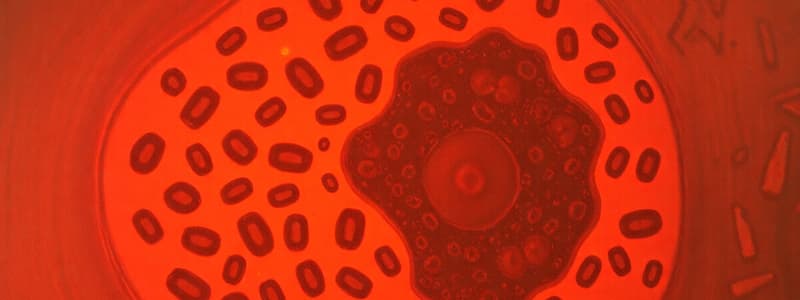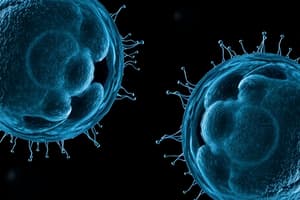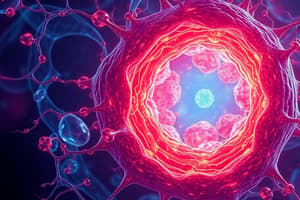Podcast
Questions and Answers
Which characteristic distinguishes epithelial tissue from the other three main types of human tissues?
Which characteristic distinguishes epithelial tissue from the other three main types of human tissues?
- Its cells have a singular, specialized function.
- It originates exclusively from a single fertilized egg.
- It's comprised of cells that facilitate rapid body communication.
- Its cells line surfaces of the body, digestive tract, and organs. (correct)
If a researcher aims to study the dynamic movements of molecules across a cell's surface, which cell shape would be most suitable for observation, considering the ease of molecular diffusion?
If a researcher aims to study the dynamic movements of molecules across a cell's surface, which cell shape would be most suitable for observation, considering the ease of molecular diffusion?
- Squamous (correct)
- Stellate
- Columnar
- Spheroid
What is the significance of cell specialization during development?
What is the significance of cell specialization during development?
- Limiting the overall growth potential of the organism.
- Increasing the genetic diversity within each cell.
- Ensuring all cells maintain identical functions.
- Allowing cells to perform specific functions efficiently. (correct)
During tissue repair, which cell type plays a crucial role in coordinating regrowth and repair by communicating with both neurons and osteocytes?
During tissue repair, which cell type plays a crucial role in coordinating regrowth and repair by communicating with both neurons and osteocytes?
How does the diversity of cell types contribute to the complexity of a human organism?
How does the diversity of cell types contribute to the complexity of a human organism?
While textbooks may state a number, what is a more accurate understanding of the estimation of human cell types?
While textbooks may state a number, what is a more accurate understanding of the estimation of human cell types?
What is the functional significance of a 'pulmonary ionocyte', given its recently discovered role?
What is the functional significance of a 'pulmonary ionocyte', given its recently discovered role?
A scientist is examining the components within the cell using a microscope. The diameter of the cell is 15 μm. What is this measurement in meters?
A scientist is examining the components within the cell using a microscope. The diameter of the cell is 15 μm. What is this measurement in meters?
In cell biology, what is the correct conversion from micrometers to nanometers?
In cell biology, what is the correct conversion from micrometers to nanometers?
When observing cells under a microscope, a researcher notes that the average diameter of a cell nucleus is approximately 5 μm, and the red blood cell is about 8 μm. Why is this information useful in cell biology?
When observing cells under a microscope, a researcher notes that the average diameter of a cell nucleus is approximately 5 μm, and the red blood cell is about 8 μm. Why is this information useful in cell biology?
What is the chief advantage of using an electron microscope compared to a light microscope, especially in the context of resolving power?
What is the chief advantage of using an electron microscope compared to a light microscope, especially in the context of resolving power?
If a researcher is examining the surface details of a cell, which type of microscopy would be most appropriate?
If a researcher is examining the surface details of a cell, which type of microscopy would be most appropriate?
How does the use of 2D images obtained through microscopy limit our understanding of cellular structures?
How does the use of 2D images obtained through microscopy limit our understanding of cellular structures?
Why is understanding the cell cycle important in biology?
Why is understanding the cell cycle important in biology?
What characterizes the mitotic phase (M) of the cell cycle?
What characterizes the mitotic phase (M) of the cell cycle?
What critical event occurs during the S phase of the cell cycle?
What critical event occurs during the S phase of the cell cycle?
If a cell duplicates its DNA content during the S phase, what implication does this have for the subsequent G2 phase?
If a cell duplicates its DNA content during the S phase, what implication does this have for the subsequent G2 phase?
How does the amount of DNA in a cell change during mitosis, and why is this change important?
How does the amount of DNA in a cell change during mitosis, and why is this change important?
What is the significance of homologous chromosomes in a normal human cell?
What is the significance of homologous chromosomes in a normal human cell?
What event precisely defines the start of anaphase in mitosis?
What event precisely defines the start of anaphase in mitosis?
Why is cytokinesis important during cell division?
Why is cytokinesis important during cell division?
What occurs during prophase?
What occurs during prophase?
During metaphase, chromosomes line up on the equator. What structure causes chromosomes to accurately line up?
During metaphase, chromosomes line up on the equator. What structure causes chromosomes to accurately line up?
A normal human cell contains 46 chromosomes. After DNA replication during the S phase, how many chromatids are present before the start of mitosis?
A normal human cell contains 46 chromosomes. After DNA replication during the S phase, how many chromatids are present before the start of mitosis?
In a cell undergoing mitosis, if an error occurs during anaphase such that one daughter cell receives an extra chromosome and the other is missing one, what is the likely outcome for these cells?
In a cell undergoing mitosis, if an error occurs during anaphase such that one daughter cell receives an extra chromosome and the other is missing one, what is the likely outcome for these cells?
Which feature characterizes telophase in mitosis?
Which feature characterizes telophase in mitosis?
What would be the result if a cell completed mitosis without undergoing cytokinesis?
What would be the result if a cell completed mitosis without undergoing cytokinesis?
Which of the phases of mitosis is primarily responsible for ensuring that each daughter cell receives an identical set of chromosomes?
Which of the phases of mitosis is primarily responsible for ensuring that each daughter cell receives an identical set of chromosomes?
If a researcher blocks the function of the centrioles in a cell about to undergo mitosis, which phase of mitosis would be most directly affected?
If a researcher blocks the function of the centrioles in a cell about to undergo mitosis, which phase of mitosis would be most directly affected?
Flashcards
What is a cell?
What is a cell?
The basic structural and functional unit of living organisms.
Types of human tissues?
Types of human tissues?
Epithelium, muscle, connective, and nervous tissue.
What are epithelial cells?
What are epithelial cells?
Cells that make up the outer layer of your body and line internal surfaces.
How is cell diversity determined?
How is cell diversity determined?
Signup and view all the flashcards
What is a pulmonary ionocyte?
What is a pulmonary ionocyte?
Signup and view all the flashcards
What is a micrometre (μm)?
What is a micrometre (μm)?
Signup and view all the flashcards
What is a nanometre (nm)?
What is a nanometre (nm)?
Signup and view all the flashcards
Name types of microscopes.
Name types of microscopes.
Signup and view all the flashcards
What is light microscopy?
What is light microscopy?
Signup and view all the flashcards
What is Electron microscopy?
What is Electron microscopy?
Signup and view all the flashcards
What is scanning electron microscope?
What is scanning electron microscope?
Signup and view all the flashcards
What is mitosis?
What is mitosis?
Signup and view all the flashcards
Phases of the cell cycle?
Phases of the cell cycle?
Signup and view all the flashcards
What happens during Interphase?
What happens during Interphase?
Signup and view all the flashcards
What happens during G1 phase?
What happens during G1 phase?
Signup and view all the flashcards
What happens during S phase?
What happens during S phase?
Signup and view all the flashcards
What happens during G2 phase
What happens during G2 phase
Signup and view all the flashcards
What are the phases of mitosis?
What are the phases of mitosis?
Signup and view all the flashcards
What happens during Prophase?
What happens during Prophase?
Signup and view all the flashcards
What happens during Metaphase?
What happens during Metaphase?
Signup and view all the flashcards
What happens during Anaphase?
What happens during Anaphase?
Signup and view all the flashcards
What happens during Telophase?
What happens during Telophase?
Signup and view all the flashcards
What is Cytokinesis?
What is Cytokinesis?
Signup and view all the flashcards
Study Notes
Cell Biology Lecture 1: Cell Size, Type, and Cycle
- The lecture aims to cover the diversity of cellular shapes and functions
- It will look at the importance of scale and measurement in understanding cells
- Different types of microscopes, limitations, and limitations of 2D images for 3D reality are to be explored
- The basics of the cell cycle and mitosis are also to be covered in this lecture
The Cell
- The structural and functional unit of living organisms
- All human cells originate from a single fertilized egg
- Development involves cell replication and specialization
Types of Tissues
- Four main types of tissues exist in humans
- These are: epithelium, muscle, connective, and nervous tissue
- Epithelial cells create the epithelium
- These cells originate from body surfaces like skin, digestive tract, and organs
Cell Shapes
-
Cells have a diversity of shapes, including:
- Squamous: thinnest cell in the body, molecules can diffuse across easily
- Spheroid: Smooth surfaces allow easy movement; it's a type of white blood cell
- Polygonal: Epithelial, has more connections
- Discoid: smooth surface allows easy movement through capillaries, red blood cells
- Cuboidal: Found in the ovary
- Fusiform (spindle shaped): Elongated cells fused together to contract
- Columnar: Intestines that absorbs nutrients from the lumen of the gut, strong polarity
- Fibrous: secretes molecules of the connective tissue in the body e.g. tendons
- Stellate: Neurons or osteocytes that coordinate regrowth and repair of body
-
Squamous, polygonal, and cuboidal cells are found in the epithelium, but have different roles
Cell Diversity Determination
- Genes lead to proteins, which determine cell structure and function
- Each cell expresses only a subset of its genes
- All cells have the same DNA at the start, but mutations arise in DNA as we age, cells are not identical
Number of Cell Types
- A textbook may say that there are 200 cell types, but new cell types are still being discovered and cellular states being analyzed
- The mission of www.humancellatlas.org is to create comprehensive reference maps of all human cells
- It serves as a basis for understanding human health, diagnosing, monitoring, and treating diseases
Pulmonary Ionocyte
- Pulmonary ionocytes are similar to salt-balancing ionocytes in fish gills or frog skin
- These account for 1% of airway epithelial cells
- They are the main source of CFTR expression involved in cystic fibrosis
Importance of Size
- Typical cells measure 5-20 μm
- Micro (µ) is 10^-6, or 1/1,000,000 (one millionth)
- One micrometre (µm) is 1/1,000,000 of a metre, or 10^-6 metre; it's also 1/1000 of a millimetre (10^-3 millimetre)
Measurements
- 1 millimetre (mm) equals 1/1000 of a metre, or 10^-3 m
- 1 micrometre (µm) equals 1/1000 of a mm, that is 10^-6 m
- A human egg is 100 um
- 1 nanometre (nm) equals 1/1000 of a µm, that is 10^-9 m
- An actin subunit is 7 nm
Cell Size
- Cell sizes range from 5 to 100 µm
- An average cell nucleus has a diameter around 5 µm
- A red blood cell is about 8 µm in diameter
Viewing Cells: Resolving Power
- The human eye can resolve down to 0.2 mm
- Light microscopes use light wavelengths and can resolve down to 0.2 µm
- Electron microscopes shine electrons at a sample and can resolve down to 0.2 nm
- Super-resolution microscopy can resolve down to 20nm
Electron Microscopes
-
Transmission electron microscopes
-
Electrons pass through the sample
-
Suited to resolving cell organelles and cell contacts
-
Scanning electron microscope
-
Electrons bounce off a sample
-
Suited to resolve the surface morphology of cells and structures
Viewing Cells: 3D to 2D
- A 2-dimensional view is what we normally see via a light microscope
- Three-dimensional views need to be constructed in our minds
- Compared to a light microscope, a Scanning EM gives a 3D perception of cells
Cell Division – Mitosis
- Mitosis is needed for growth and repair
- Some cells are too specialized to divide while some divide very rapidly.
The Cell Cycle
- Most cells spend time in the G1 phase for growth and normal metabolism functions.
- When a cell chooses to divide, it enters the S-phase where it doubles all of its DNA.
- It then prepares to divide in G2.
Chromosomes
- Normal human cells contain 46 chromosomes, or 23 pairs
- Chromosomes come from our mothers and fathers
- In the S phase, each chromosome doubles its DNA content, forming 2 chromatids joined by a centromere
- A diploid cell has the full set of chromosomes, whilst a haploid cell has half (only the eggs)
Cell Cycle Phases – Interphase
G1 phase (gap phase 1) - phase of growth and normal cellular activities S Phase, or synthetic phase - DNA replication stage taking 6-8 hours G2 phase (gap phase 2)
- short phase that prepares for cell division
- takes 3-4 hours
Cell Cycle Phases - Mitosis
- Prophase: Chromosomes condense and become visible, the nuclear membrane disappears, and the mitotic spindle starts to form from centrioles
- Metaphase: chromosomes line up on the equator and the spindle is fully formed
- Anaphase: the chromosomes split at the centromeres with each half of the chromosomes going to the different pole to the different centriole
- Telophase: decondensation of chromatin, reformation of nuclear envelope, and cytokinesis (where cells begin to separate into 2 daughter cells)
Studying That Suits You
Use AI to generate personalized quizzes and flashcards to suit your learning preferences.




